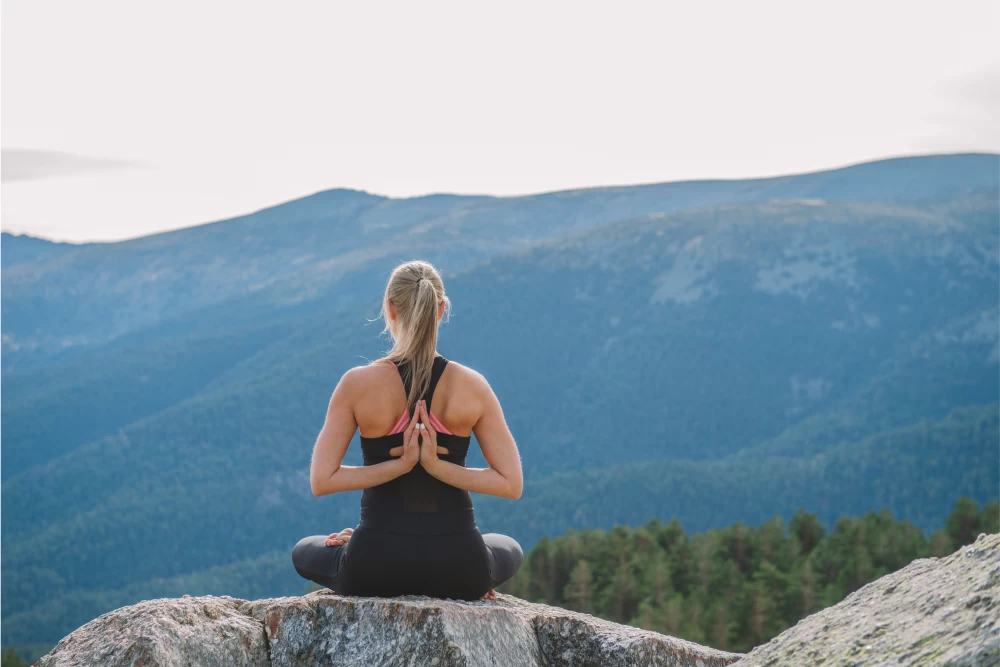
- 15th May 2023
Table of Contents
How Yoga and Meditation Can Help You
Yoga and meditation have many positive effects. The physical benefits of yoga include enhanced mobility, stamina, and equilibrium. As a result of its emphasis on deep breathing and calming postures, it can also help people feel less stressed and anxious. However, meditation can help quiet the mind and bring about greater focus and clarity by training attention on the breath or some other object. Regular yoga and meditation practise has been shown to improve cardiovascular health, boost immunity, and even alleviate depressive symptoms. These practises not only help you feel better on the outside, but they also help you feel better on the inside by increasing your self-awareness and calming your mind. Incorporating practises like yoga and meditation into daily life has been shown to improve mental and physical health and overall well-being. These practises, whether learned in a classroom setting or carried out independently, can have positive effects on one's physical and mental health.
How the Mind Affects the Body
The mind-body connection can be strengthened through the practises of yoga and meditation. Yoga is a practise that aims to strengthen the body and calm the mind through a series of postures, breathing exercises, and meditation. It has been hypothesised that regular yoga practise can improve mental and physical health by decreasing stress, anxiety, and depression. The mind-body connection can be strengthened through other practises as well, such as meditation. Concentration is the practise of paying close attention to one thing for a long time. Focus, relaxation, stress, and anxiety all decrease with regular meditation, and the immune system also benefits. The benefits of each practise on their own are substantial, but when combined, they become enormous. If you want your body and mind to be more ready for meditation, try doing some yoga first. The positive effects on both mental and physical health from combining physical movement with focused attention have been well documented.

Hatha Yoga, Vinyasa Yoga, and Kundalini Yoga are all distinct branches of the practise
In the West, most people who practise yoga do so in the form of Hatha yoga. It is a slow and relaxing style of yoga that emphasises fundamental poses and breathing techniques. Strength, flexibility, and equilibrium can all be improved by holding Hatha yoga poses for longer. This style of yoga is ideal for newcomers because it lays the groundwork for more advanced yoga techniques. On the other hand, Vinyasa is a vigorous and rapid-fire yoga practise that synchronises breath with movement. It's characterised by a fluid sequence of poses that are performed in time with the breath. Vinyasa is a great way to get a good workout and cultivate awareness through physical activity. Physical postures, breathing exercises, meditation, and chanting are all part of Kundalini yoga. The purpose of Kundalini is to stimulate the flow of chi (energy) from the base of the spine to the body's seven chakras. Kundalini can be a challenging practise, but it is said that those who engage in it regularly over time experience a profound inner transformation. In the end, it doesn't matter which style you choose because they all contribute in their own way to your overall mental and physical health and well-being.

Learning Appropriate Breathing Methods
Breathing correctly is crucial not only in yoga and meditation, but in all aspects of life. Managing your breathing is one of the cornerstones of yoga practise, and it has been shown to have a calming effect on the mind and body. Proper breathing techniques increase the amount of oxygen reaching the brain, organs, and muscles, which in turn boosts performance. Proper breathing techniques not only improve physical health, but also positively affect mental health. By slowing down the autonomic nervous system, conscious breathing aids in emotional regulation. Anxiety and depression sufferers can benefit greatly from this method. Regular deep breathing can help people deal with their negative thoughts. Last but not least, better sleep and better digestion are just two more outcomes that can result from incorporating proper breathing into daily activities. Taking some slow, deep breaths before bed can help you feel more at ease all night long. Taking deep breaths while eating has been shown to improve digestion by increasing blood flow to the digestive organs. In conclusion, learning and using effective breathing techniques has many positive effects on health and well-being.
The Value of Consistent Training
The mind and body reap many rewards from consistent yoga and meditation practise. Flexibility, strength, and mental health are just some of the benefits of regular yoga practise. Better sleep may be another benefit of practising yoga. Clearing your head through meditation can help alleviate stress and lift your mood. Studies have shown that people who meditate regularly report higher levels of happiness and well-being. Mindfulness In particular, meditation has been shown to be helpful in alleviating distress. Yoga and meditation are each beneficial on their own, but when practised together, they can have a profound effect on one's health. Physical and mental fortitude, mental acuity, stress levels, and the ability to control one's emotions may all improve with consistent practise.
How to Make Meditation Part of Your Daily Life
The two practises of yoga and meditation complement one another. Meditation is meant to help you calm your mind and increase self-awareness, while yoga is more concerned with physical postures to improve flexibility, strength, and balance. You can improve your mental and physical well-being by making meditation a regular part of your life. Setting aside regular time each day to meditate is a good first step towards making meditation a regular part of your life. It could be as short as five minutes or as long as an hour, whichever is more convenient. Sit comfortably with your eyes closed in a quiet, undisturbed area, and bring your attention to your breathing. Guided meditations are another option, and you can find many of them online or in apps made especially for meditation. Using a guided meditation can help you maintain concentration and give you direction as you meditate. Finally, keep in mind that you'll need to be patient and consistent if you want to make meditation a regular part of your life. Don't give up if at first you find it challenging; developing this habit or skill, like any other, takes time and effort. However, consistent meditation practise can have profound effects on one's life if one is patient and committed to reaping its benefits.
Conclusion
In conclusion, it is crucial to prioritise self-care. Physical and mental well-being can be supported through regular yoga and meditation practise. Yoga is a fantastic form of exercise because it helps you maintain a healthy body and a peaceful state of mind. It's good for your endurance, muscle strength, and flexibility. When combined with yoga, meditation can help you stay in the present and calm your mind even further. Take care of yourself by dedicating time each day to a self-care practise like yoga or meditation. Ten to fifteen minutes a day is all it takes to start making a difference in your health and well-being. Hatha, Vinyasa flow, and Ashtanga are just a few of the many yoga traditions from which to choose. Similarly, you can find calm within yourself and enhance your focus by practising one of the many forms of meditation available, such as mindfulness or loving-kindness. In conclusion, making self-care practises like yoga and meditation a priority can have positive effects on one's physical well-being, mental acuity, sleep, and anxiety levels. Consequently, it is critical to schedule regular "me-time" to kickstart your journey towards holistic wellness right away.
